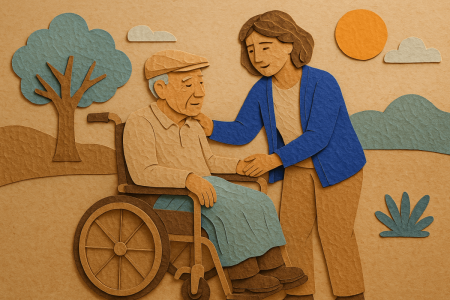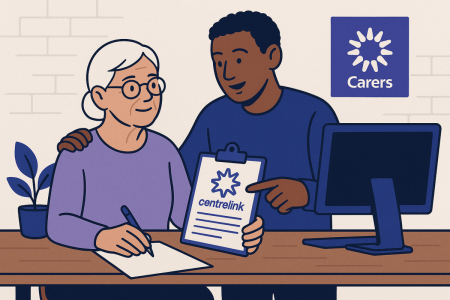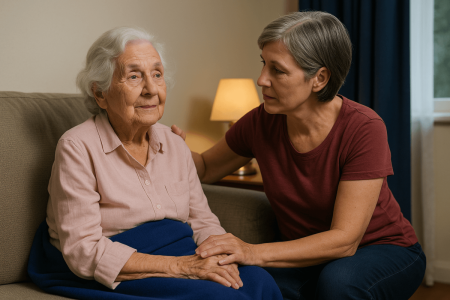Retired, caring, and counting: What Carer Allowance means for older Aussies
- Replies 0
Caring in Retirement – A New Role
Many Australians expect retirement to be a time of relaxation, but for thousands it brings a new full-time job: caring for a loved one. Whether it’s a husband looking after his wife with dementia or a grandmother raising a grandchild with special needs, senior carers are more common than you might think.In fact, over a quarter of primary family carers are aged 65 or older. Often, it’s a spouse caring for their long-time partner through illness or frailty.
Stepping into a carer’s shoes in one’s golden years can be rewarding but also challenging – emotionally, physically and financially. This is where the Australian government’s Carer Allowance aims to help.
Carer Allowance is a modest fortnightly payment designed to assist with the extra costs of caring for someone who needs daily support due to disability, illness or age-related frailty. For retirees on fixed incomes, every bit counts.
So what exactly is Carer Allowance, who can get it, and how does it help older Australians caring for family?
What is the Carer Allowance?
Carer Allowance is a fortnightly Centrelink payment for people who provide daily care to someone with a severe disability, medical condition, or who is “frail aged”. It’s meant to offset some of the additional costs of caring, on top of normal living expenses.This could include things like extra gas for driving to medical appointments, higher utility bills from running medical equipment at home, or other out-of-pocket expenses that come with looking after someone. It’s not a wage for caring – think of it more like a small financial boost to acknowledge the added costs and responsibilities carers take on.
As of mid-2025, the Carer Allowance pays $159.30 per fortnight. This rate is indexed (adjusted) each year – for example, in January 2025 it went up by $5.80 to the current amount. Importantly, Carer Allowance is not taxable income, and it generally doesn’t affect your other pensions or payments. In other words, eligible carers can receive this allowance in addition to other benefits like the Age Pension. (It’s different from the Carer Payment, which is a separate full income support pension for full-time carers – more on that later.)
Each July, Carer Allowance recipients also get an extra Carer Supplement of $600, an annual lump sum to further help with costs.
It’s a set rate paid fortnightly – unlike some payments, it doesn’t vary based on your assets or most income. In fact, you can earn income from work and still get the full Carer Allowance as long as you and your partner’s combined adjusted taxable income is under $250,000 a year.
There’s no asset test at all for Carer Allowance. This high income threshold means virtually all retired Australians (other than the very wealthiest) wouldn’t be disqualified by income. The allowance is essentially a flat benefit intended to reach a broad range of carers. According to Services Australia, the payment isn’t counted towards your taxable income, which can give some peace of mind that it won’t push you into a higher tax bracket or reduce an income-tested pension.
While $159 a fortnight may not sound like much, over a year it adds up to around $4,140, plus the $600 supplement – money that can make a real difference for those living on tight budgets. As one carer advocate noted, these payments work out to only “cents on the hour” when compared to the value of 24/7 care, yet for many families they help cover a few bills and relieve a bit of pressure.
More than 600,000 Australians receive Carer Allowance, underscoring how many people rely on this support while caring for loved ones.
Who Qualifies for Carer Allowance?
Eligibility for Carer Allowance revolves around the caregiving role and the care recipient’s needs rather than traditional means-testing. To qualify, both the carer and the person being cared for must meet certain criteria:- You must be providing daily care and attention to someone who needs significant ongoing help with their day-to-day living. This care must be provided in either their home or yours on a daily basis. (So if you are looking after your partner at home, or you drive each day to your elderly parent’s house to help them, that generally counts. But occasional or infrequent care likely wouldn’t.) The care needs to be part of everyday life – help with things like feeding, bathing, mobility, supervision or medical needs, depending on the person’s condition.
- The condition of the person you care for must be substantial and long-term. The person must have a disability, chronic illness, mental illness, or frailty due to age that requires care for at least 12 months (or is terminal). In practice, this usually means the person has a doctor-verified condition that causes a medium to high level of dependency. For example, this could be an age-related issue like advanced dementia or Parkinson’s disease, after-effects of a stroke, or a serious health condition or disability. A short-term injury or illness (like recovering from surgery with an end in sight) wouldn’t qualify – it needs to be something ongoing. Carer Allowance can be paid for caring for people of any age (children or adults), but the rules differ slightly if the person is under 16. Many older carers are looking after an adult – often their spouse, sibling, or adult child.
- Assessment by a medical professional is required. As part of the claim process, Centrelink will need evidence of the care recipient’s condition and need for care. Typically, the treating doctor of the person you care for has to fill out a detailed medical report or form confirming the diagnosis and the level of assistance needed. In some cases, existing medical records or assessments (like an Aged Care Assessment Team report, or disability support pension medical evidence) can be used. The idea is to verify that the person’s condition meets the thresholds for Carer Allowance. This might involve a rating system – for instance, adults are often assessed under the Adult Disability Assessment Tool (ADAT) which gives a score based on how much care they need in daily activities.
- Both you (the carer) and the person you care for must meet basic residence rules. Generally, this means you are Australian residents currently living in Australia. Usually, citizens, permanent residents, and certain visa holders can qualify, but you must be residing in Australia. The person being cared for also usually needs to live in Australia. (You can’t typically get Carer Allowance for caring for someone overseas, and if either of you travel or move overseas, you’d need to check how that affects the payment.)
- Income test: As mentioned, there is only an income limit, not an asset test. Your adjusted taxable income (ATI) combined with your partner’s, if you have one, must be under $250,000 per year. ATI includes most taxable income sources. The vast majority of retired folks have nowhere near that income level, so practically this isn’t a barrier for typical seniors. There’s no income test applied to the person you are caring for – for example, if you care for an elderly spouse who gets the Age Pension or even has a salary or investment income, that doesn’t directly affect your Carer Allowance (only the carer’s own income is considered, and only if extremely high). And again, other assets like your house, savings, super, etc., are not considered at all for Carer Allowance eligibility.
It’s worth noting that Carer Allowance can be paid for more than one person if you care for multiple people. If, say, an older couple are each caring for a disabled adult child at home, or you care for two frail parents, you might be able to get separate Carer Allowance payments for each care recipient (up to certain limits).
However, you generally cannot get two full allowances for caring for the same person with another carer – if two people share caring for one individual, they might split the allowance. For example, siblings sharing care of an elderly parent could each receive a part-rate Carer Allowance proportional to the care they provide. (If the other carer is your partner, typically only one Carer Allowance is paid per care recipient to a couple.)
Finally, one more nuance: Carer Allowance is different from Carer Payment, which is the Centrelink payment for carers who cannot work at all because they are full-time caring. Carer Payment is essentially an alternative to the Age Pension or Disability Pension – it’s income and asset-tested and pays a full pension rate (around $1,116 per fortnight for a single).
You generally cannot receive Carer Payment and Age Pension at the same time (you must choose one). However, Carer Allowance can be paid on top of the Age Pension or other payments because it’s considered a supplementary support.
Many retired carers are on the Age Pension and receive Carer Allowance to help with their extra caring costs. This stacking is allowed and common.
How to Claim the Allowance
Applying for Carer Allowance is done through Services Australia (Centrelink). For those comfortable online, the quickest way is to use a MyGov account linked to Centrelink and complete the claim digitally. You’ll need to fill out the Carer Allowance claim form, and as mentioned, part of the process involves getting a medical report about the person you care for.The form for the doctor (often called the Medical Report for Carer Allowance) can be downloaded or provided by Centrelink; it needs to be completed by the GP or specialist who knows the patient’s condition. This form details the diagnosis and the person’s care needs, which Centrelink uses to assess eligibility.
Online: To claim online, log into MyGov and go to Centrelink, then find the option to “Make a claim.” Under the Carers category, you’ll start a claim for Carer Payment/Carer Allowance (it’s a combined form, since some people apply for both). The system will ask questions about your situation, income, the person you care for, and the care you provide. You can save your progress and come back if needed.
You will have to upload supporting documents – primarily identification documents for yourself (if not already verified) and the medical form for the care recipient. Services Australia will guide you if any other documents are needed as you go.
Offline/Phone: If you’re not tech-savvy or prefer personal help, you can also apply by phone or in person. You can call the Centrelink Disability, Sickness and Carers line and lodge a claim over the phone, or have the forms sent to you. Centrelink can mail out a paper claim form that you fill in and return.
Visiting a service centre is another option – staff can provide the forms and usually give basic guidance, though they often encourage online claiming. (Keep in mind, during peak times or pandemics, they advise not to visit in person unless necessary, but the option is there, and many seniors do prefer face-to-face service.)
When filling out the claim (whether online or paper), you’ll need to provide details about the care recipient’s daily needs. Be prepared to answer questions on tasks you help with (like feeding, dressing, mobility, communication, etc.) and how often you provide this help. This is used in an assessment tool that assigns points to determine if the care level meets the threshold. It’s important to be honest and thorough – if you downplay the level of care (perhaps out of modesty or because you take it in stride), you might accidentally make it seem like less care is required than truly is. Don’t assume something is too trivial to mention. For example, if you have to help your spouse shower and dress every day, or you supervise them due to dementia, include that information. These daily activities are exactly what the allowance is meant to support.
Also, make sure the person you care for is willing to have you as their carer – they will need to sign some forms or declarations too, since essentially you are making a claim that involves them. (If they are an adult with capacity, they need to consent; if not, there are provisions for nominees or people with power of attorney to act on their behalf.)
Once you submit the claim, Centrelink will process it and may contact you if more info is required. Processing times can vary, but it’s wise to get the paperwork in as soon as you’re eligible. If approved, Carer Allowance can be backpaid to the date you lodged the application (or earlier if you had advised intent to claim).
You will receive a notification of the decision in your MyGov inbox or by mail. If granted, payments will start fortnightly into your bank account. If for some reason your claim is rejected and you believe you met the criteria, you can request a review or appeal – sometimes additional evidence or clarification can overturn an initial denial.
Keep in mind that if your circumstances change, you need to inform Centrelink. For example, if the condition of the person you care for improves significantly, or if they go into residential care or hospital for a long period, or if you stop providing care, the allowance may need to stop.
Short hospital stays or respite breaks are usually fine (Carer Allowance generally continues if the person you care for is in hospital for up to hospital for up to 12 weeks) – but you must update Centrelink after 12 weeks in care, as payments typically cease after that unless an extension is granted. Also, if your situation changes (like moving overseas or your income unexpectedly rising above $250k – a windfall, perhaps), you’d report that too.
For older carers, navigating Centrelink can be daunting, but there are supports. You can have a family member or friend nominee to help deal with Centrelink on your behalf if paperwork isn’t your strong suit. And community organizations like Carer Gateway and Carers Australia offer help and advice on the process as well.
Carer Allowance and Retirees – What It Means in Practice
For senior Australians, the Carer Allowance can be a critical support that runs alongside the Age Pension or other retirement income. Many retirees live on limited budgets, so an extra ~$80 a week can go toward essentials – petrol for driving your partner to the doctor, covering higher electricity bills from running the heater for an unwell spouse, or buying incontinence pads and medications not fully covered by other schemes.It’s not a huge amount, but carers often say “every little bit helps” when you’re stretching dollars. It can also validate the caring role in a symbolic way; knowing that the government recognizes your unpaid labor can be an emotional boost, however small the payment.
Notably, Carer Allowance does not reduce your Age Pension. Since it’s not means-tested (apart from that very high income cap) and isn’t taxable, it won’t count as income under the pension income test. So if you’re an age pensioner, you can essentially keep your full pension and get the $159.30/fortnight on top – a valuable combination for those doing it tough. (By contrast, if you tried to claim Carer Payment as a pensioner, you’d have to swap off the Age Pension to get Carer Payment, which usually isn’t beneficial unless you weren’t yet of pension age or your partner isn’t – a complex scenario beyond this scope.)
For self-funded retirees or part-pensioners, Carer Allowance might be the only government payment they qualify for, since their assets or super might exclude them from pensions. Because Carer Allowance doesn’t look at assets, even a homeowner with some savings can receive it as long as their taxable incomes are under the threshold.
That means even if you’re not on Centrelink otherwise, you should check if you can get Carer Allowance – it won’t hurt any other entitlements and can supplement your private income.
Let’s consider a scenario: Jim, 70, is caring for his 68-year-old wife Maureen who has Parkinson’s disease. Jim and Maureen both get the Age Pension at the couple rate. When Maureen’s condition progressed to the point she needed help with showering, dressing, and mobility around the house, Jim became her primary carer. A social worker at the hospital told Jim about Carer Allowance. He applied and was granted the allowance, which now gives them an extra $159.30 a fortnight.
Jim says this money helps pay for the petrol for frequent medical appointments and the increased grocery bills (since he now buys some ready-made meals on days he’s too busy caregiving to cook). It also helps cover the gap for medications and the occasional piece of mobility equipment.
“It’s not a lot, but it covers a few tanks of fuel and some of Mum’s meds each month,” he says. The couple also received a $600 Carer Supplement in July, which they put toward hiring a cleaning service a couple times, giving Jim a breather from household chores.
Now, $160-ish a fortnight is a far cry from a full-time carer’s needs. Some older carers reduce their work hours or leave work entirely to care for someone (if they were still working to begin with). In Jim’s case, he was already retired. But consider those just under pension age: a 64-year-old caring for a spouse might not yet get the Age Pension, so they could apply for Carer Payment (the pension-equivalent for carers) if eligible or perhaps rely on their savings or super.
For them, Carer Allowance alone would likely not be enough to live on – it’s intended as a supplement, not a standalone income. Carer Allowance is equivalent to roughly $11 per day, so it’s not going to replace a salary or pension. It is, however, an acknowledgment and a help with out-of-pocket costs.
The Reality for Older Carers – Challenges and Personal Stories
Behind the policies and payments, it’s important to remember the human side: retirees who had plans for a carefree retirement but instead devote their days (and nights) to looking after loved ones. Many older carers find meaning and purpose in their role, but it can be isolating and exhausting too.The Carer Allowance, while appreciated, is just one piece of the support puzzle. Community services, respite care, and family help (if available) are also crucial to help senior carers cope.
Real-life stories in the media have highlighted both the dedication of older carers and the financial struggles they face. Beth Jackson, for example, is a woman in her 60s who cared for her elderly mother with dementia for over 13 years. Beth put her career as a psychologist on hold to move in and look after her mum full-time. During those years, she survived on the government’s Carer Payment (the pension for carers) and the Carer Allowance, as her caring duties were 24/7.
“You get all the empty words from people telling you what a great job you are doing… The day you stop being a carer, those words mean absolutely nothing and you’ve got nothing to show for it,” Beth reflected, noting how after her mother went into aged care, her Carer Payment and Allowance stopped.
Suddenly, she found herself on JobSeeker (unemployment benefit) while grieving the loss of her mum and her role. Financially, it was a shock – she said she at times couldn’t afford proper food, surviving on eggs from her backyard chickens. Eventually, Beth qualified for a Disability Support Pension due to her own health issues, but she had missed out on over a decade of superannuation contributions and career advancement.
Her story, featured on ABC News, underscores the lifetime financial cost many carers bear. On average, Carers Australia estimates a typical carer will lose hundreds of thousands of dollars in forgone earnings and retirement savings over their caregiving years.
For older couples, the scenario might be one partner caring for the other through a long illness. These are often heart-warming but also heart-wrenching stories.
Take Pat and Ed, a couple married 53 years, profiled by the ABC: Ed became the full-time carer for Pat after she developed Alzheimer’s disease in her 70s. Ed managed as best as he could as Pat’s memory and independence faded, determined to keep her at home with him as long as possible.
Like many in his shoes, Ed likely became eligible for Carer Allowance once Pat’s care needs grew. Such couples often express that love is what motivates their care, but they also acknowledge the strain.
“It’s just going to get worse,” one carer-husband said candidly of his wife’s dementia progression. Having some financial support can at least ease the material burden – perhaps allowing them to hire respite care for a few hours, or simply not having to worry about the next electricity bill.
Is the Carer Allowance enough? Many advocacy groups say no – at least, not by itself. They argue that carers, especially those who have given up work, need greater financial recognition. Carer Allowance has been criticized for not keeping up with the cost of living over the years. A decade ago it was about $123/fortnight; now it’s $159 – an increase, but not a huge one relative to inflation. One ABC report noted that for many years the rate hardly budged except for small indexation bumps, contributing to carers feeling left behind.
Carers SA pointed out that when Carer Allowance was first introduced (back in the late 20th century), it was roughly 25% of the couple Age Pension rate, whereas today it has shrunk to only about 10% of a couple’s pension. In short, the pension has increased more (with wage growth and larger boosts over time) while Carer Allowance’s relative value dropped.
By Carers Australia’s calculations, the allowance would need to increase 150% (to about $400 a fortnight) to get it back to that original value relative to the pension. That kind of increase would cost the government nearly $2 billion extra per year – so it’s no small ask.
In late 2023, a carer named George Helon made news describing the inflation adjustment to Carer Allowance as an “insult”, after it rose by only a few dollars. He and others petitioned the government for a better deal, arguing that unpaid carers save the country billions in healthcare and aged care costs, yet often live in poverty or financial stress themselves.
It’s a delicate debate – governments recognize the value of carers, but budget constraints and philosophies on welfare mean the Carer Allowance is unlikely to turn into a large stipend anytime soon. The current federal government has noted it is indexing payments and examining adequacy of supports via an Economic Inclusion Advisory Committee, but no major overhaul of Carer Allowance has been announced as of mid-2025.
For now, older carers can take some reassurance that the support available is at least moving in the right direction (however slowly). Each March and September, pension payments including Carer Payment are indexed, and each January, supplements like Carer Allowance are indexed too.
In March 2025, the Age Pension and Carer Payment rose by about $19.60 a fortnight for singles, and similarly, Carer Allowance’s January 2025 rise of $5.80 acknowledged rising costs. Over 600,000 carers benefited from that increase. It’s not a windfall by any means, but it shows the allowance is not entirely forgotten in policy updates.
Beyond the dollars and cents, many senior carers say having official support – even a small payment – gives them a sense that their role is recognized. There is also emotional and practical support available: Carer Gateway, for example, is a government-funded service that offers counseling, respite referrals, and advice for carers of all ages. Charities and local councils sometimes have additional concessions (such as respite care days or discounts) for those on Carer Allowance.
For example, holding a Carer Allowance Health Care Card (provided automatically if you care for a child under 16) can help with medical costs, and although adults on Carer Allowance don’t get a health care card for the cared person, the person might already have a Pensioner Concession Card or similar if they’re of age or on disability support. It all weaves into a web of supports aimed at helping seniors care for seniors.
Looking Ahead – A Question for You
Australia’s population is aging, and more retirees will likely find themselves stepping into caring roles. The Carer Allowance is one way our society tries to support those who support others. It’s not a life-changing sum of money, but for many it’s a crucial help to get by and keep their loved ones at home longer.As discussions continue about how to value unpaid carers – from proposals to pay superannuation for carers, to increasing allowances – one thing is clear: the role of older carers will only become more important in our communities.
Have you navigated the Carer Allowance or cared for a loved one in retirement, and do you think the current support is enough? It’s a conversation worth having, as Australia considers how to best look after those who devote their time to caring for family in later life.
Read More: ‘They’re already struggling’: New changes to aged care spark fear among families










